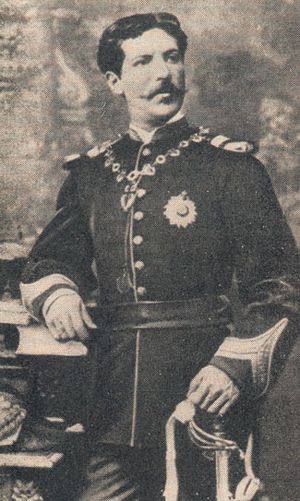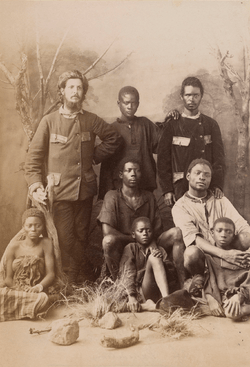Alexandre de Serpa Pinto facts for kids
Quick facts for kids
Alexandre Alberto de Serpa Pinto
|
|
|---|---|
 |
|
| Born | 20 April 1846 Cinfães, Kingdom of Portugal
|
| Died | 28 December 1900 (aged 54) |
| Nationality | Portuguese |
| Alma mater | Colégio Militar |
| Occupation | Soldier, explorer, colonial administrator |
| Office | Colonial governor of Cape Verde |
| Term | 20 January 1894 – 17 January 1898 |
| Predecessor | José Guedes Brandão de Melo |
| Successor | João Cesário de Lacerda |
| Military career | |
| Allegiance | |
| Service/ |
|
| Years of service | 1864 – 1890 |
| Rank | Colonel |
Alexandre Alberto da Rocha de Serpa Pinto (born April 20, 1846 – died December 28, 1900) was a famous Portuguese explorer. He explored parts of southern Africa and also worked as a colonial administrator. He is often known simply as Serpa Pinto.
Contents
Early Life and Military Career
Serpa Pinto was born in a small Portuguese village called Cinfães. This village is located by the Douro River. When he was 10 years old, he joined the Colégio Militar, which is a military school.
In 1864, at age 18, he joined the Portuguese army. He was sent to Portuguese Mozambique, a Portuguese colony in Africa. In 1869, he helped to stop local tribes from revolting near the lower Zambezi River.
Exploring Africa
First Expeditions
Serpa Pinto's journey as an explorer began in 1869. He traveled to eastern Africa to explore the Zambezi River.
Eight years later, in 1877, he led a new expedition. This journey started from Benguela, a city in Portuguese Angola. His goal was to explore the areas around the Congo and Zambezi rivers.
The town of Menongue in Angola was even named Serpa Pinto after him until 1975.
Crossing Africa
In 1877, Serpa Pinto joined two other Portuguese navy officers, Capelo and Ivens. They were all experienced in Africa. Their mission was to explore the southern African interior. They started their journey from Benguela in November.
However, they soon went separate ways. Capelo and Ivens headed north. Serpa Pinto continued eastward, slowly moving south. He crossed the Cuando (Kwando) in June 1878. By August, he reached Lealui, which was the capital of the Barotse on the Zambezi River.
A missionary named François Coillard helped him there. This help allowed Serpa Pinto to continue his journey along the Zambezi. He reached the amazing Victoria Falls. After that, he turned south. He finally arrived in Pretoria, South Africa, on February 12, 1879.
Meanwhile, Capelo and Ivens reached Dondo in northern Angola. Serpa Pinto became the fourth explorer to cross Africa from west to east. He was also the first to map a fairly accurate route between Bié (in modern-day Angola) and Lealui.
Awards and Publications
In 1881, the Royal Geographical Society gave Serpa Pinto a special award. It was called the "Founder's Medal." He received it for his journey across Africa. He had explored 500 miles of new land.
That same year, Serpa Pinto published a two-volume book. It was titled Como eu atravessei a África (How I crossed Africa). It was quickly translated into English, French, and German.
Adventures in the Nyasa Region
In 1879, the Portuguese government claimed land south and east of the Ruo River. This river is now part of Malawi's border. In 1882, they took control of the lower Shire River valley. Portugal then tried to get Britain to agree to their land claims. But the Berlin Conference in 1884 stopped these talks.
In 1884, Serpa Pinto was made the Portuguese consul in Zanzibar. His new job was to explore and map the area between Lake Nyasa and the coast. He also had to make agreements with local chiefs in that region.
In 1885, Serpa Pinto led another expedition with Lieutenant Augusto Cardoso. Serpa Pinto became very sick during this trip. He had to be carried to the coast to recover. His lieutenant, Cardoso, continued the exploration. He visited Lake Nyasa and the Shire Highlands. However, he could not make protection agreements with the local Yao chiefs.
Britain did not agree that the Shire Highlands belonged to Portugal. To prevent Portugal from taking over, Britain sent Henry Hamilton Johnston. He was a British consul. His job was to check Portuguese rule in the Zambezi and Shire valleys. He also had to make agreements with local rulers outside Portuguese control. This was to stop them from accepting Portugal's protection.
In 1888, Portugal told its people in East Africa to make agreements with the Yao chiefs. These chiefs lived southeast of Lake Malawi and in the Shire Highlands. An expedition led by Antonio Cardoso started in November 1888. Later, a second expedition led by Serpa Pinto moved up the Shire valley. Serpa Pinto had been made governor of Mozambique. Together, these two expeditions made over 20 agreements with chiefs in what is now Malawi.
In August 1889, Serpa Pinto met Johnston. Johnston told him not to cross the Ruo River into the Shire Highlands. Even though Serpa Pinto had been careful before, he crossed the Ruo in September 1889. After some small fights, Johnston's assistant, John Buchanan, declared the Shire Highlands a British protectorate. This was later approved by the British government.
Later Life and Legacy
After these events with Britain, Serpa Pinto went back to Portugal. He was promoted to the rank of colonel. From 1894 to 1898, he served as the governor general of Cape Verde.
Serpa Pinto passed away in Lisbon on December 28, 1900, at 54 years old. He was buried in a family grave in Lisbon.
Honors and Recognition
Serpa Pinto received many honors for his work. In Portugal, he was given several important awards for knights. Other countries also honored him. France gave him the Cross of the Ordre National de la Légion d'Honneur. Brazil made him a knight of the Ordem da Rosa. Turkey honored him with the Great Cross of the Order of the Medejidie.
He also became an honorary member of scientific groups. This included the French Académie des Sciences' Astronomy division. He also received the "Founders' Medal" from the Royal Geographical Society in London. In 1899, King Carlos I gave him the noble title of Viscount.
Many streets and squares in Portuguese towns are named after him. For example, there is Rua Serpa Pinto in Lisbon and Porto. In Angola, the town of Serpa Pinto (now Menongue) was named after him. His name was even given to two ships and used for products like cigars and biscuits.
His picture appeared on stamps and on a banknote from Angola. In Cinfães, the Serpa Pinto Museum opened in 2000. It has exhibits about this famous explorer. There is also a bust of him in front of the museum. The house where his parents lived has been turned into a hotel. One of its halls is named after Serpa Pinto.
An organization called the Associação Cultural Serpa Pinto (ACSP) was founded in 2007. This group works to develop cultural, social, and scientific activities. They also want to protect Serpa Pinto's legacy. They encourage the study of his life and work. The association has a library, conference rooms, and exhibition spaces.
See also
 In Spanish: Alexandre de Serpa Pinto para niños
In Spanish: Alexandre de Serpa Pinto para niños


